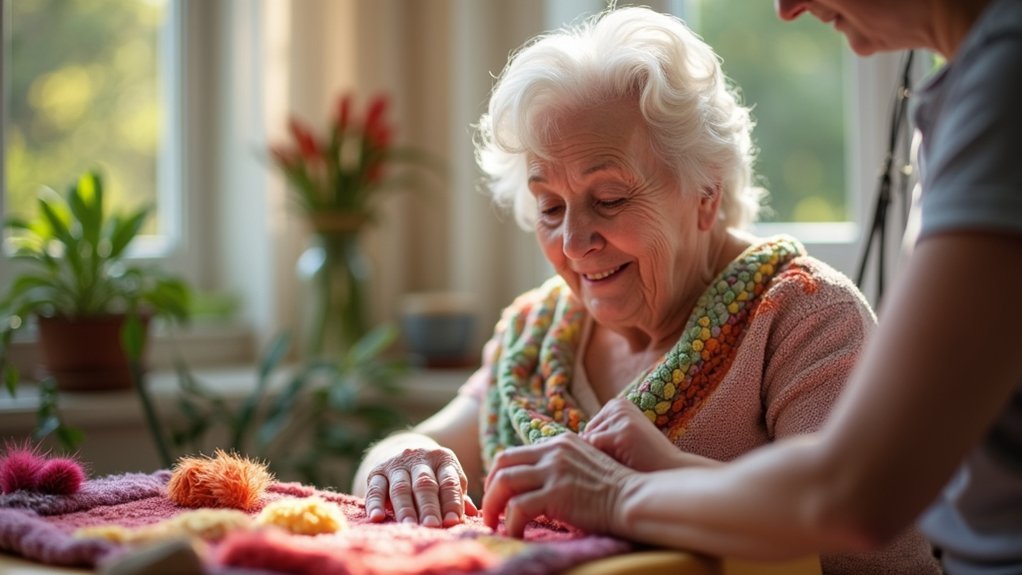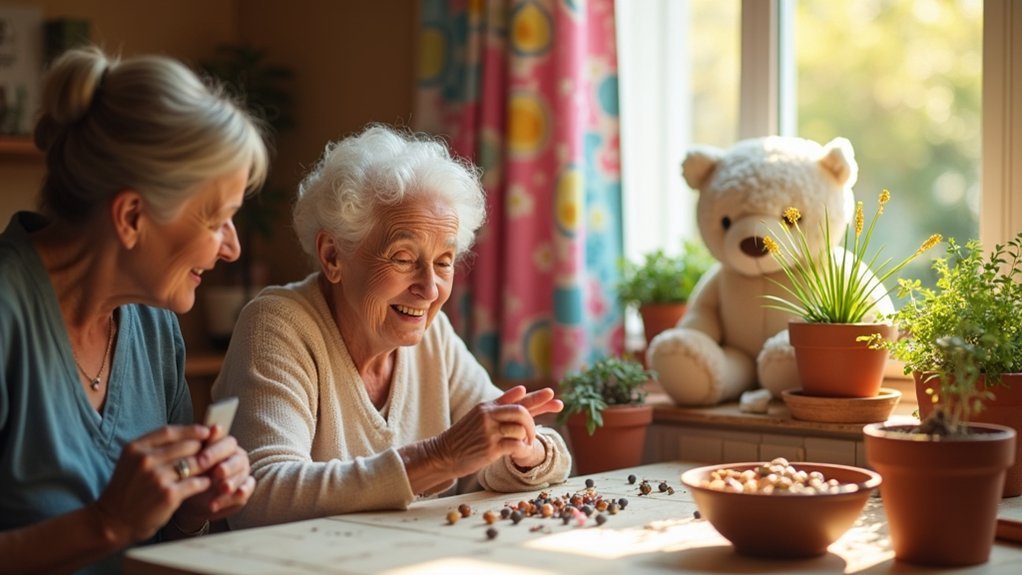Sensory activities benefit dementia patients by activating multiple neural pathways, bypassing damaged brain areas. You’ll see immediate improvements in mood, reduced agitation, and stronger social connections. These activities can reveal memories previously thought lost through familiar textures, sounds, smells, and objects that trigger emotional responses. When personalized to individual preferences, sensory stimulation creates meaningful moments of connection and joy. Discover how simple tactile games and multisensory experiences can transform dementia care.
The Science Behind Sensory Stimulation for Dementia Patients

While the brain changes considerably during dementia, sensory stimulation offers promising approaches to enhance quality of life for patients. When you engage multiple senses simultaneously, you’re activating neural pathways that can potentially improve cognitive function and compensate for sensory deficits common in dementia.
This non-pharmacological approach works by targeting unaffected sensory pathways when others decline. Research shows immediate positive effects on behavior and mood following multisensory experiences, though long-term outcomes require more study. The neurological benefits occur because these activities can stimulate memory-related neural connections that might otherwise remain dormant. Activities like music therapy can evoke calmness and trigger reminiscence in patients who struggle with other forms of communication.
You’ll find that customized sensory environments provide safe spaces for exploration while addressing individual preferences. When traditional communication becomes challenging, sensory interventions can bridge gaps and maintain essential human connections.
How Multisensory Activities Reduce Agitation and Anxiety
When dementia patients experience agitation and anxiety, multisensory activities offer powerful relief by engaging multiple neural pathways simultaneously. Studies show these interventions reduce agitation more effectively than one-to-one activities alone.
You’ll find that personalized sensory experiences can be tailored to each patient’s preferences. Aromatherapy with familiar scents improves mood, while touch therapy provides alternative communication for those with verbal difficulties. Soothing sounds, engaging visuals, and familiar tastes all work together to create calm.
Specialized sensory rooms provide controlled environments that comfort and reassure patients. The widely used Snoezelen therapy provides a relaxing, exploratory environment where patients can engage with sensory stimuli of their choice without requiring cognitive processing. For best results, consider cultural context when designing interventions—culturally adapted approaches show significant benefits, particularly when combined with personal comfort items that enhance security feelings.
While immediate benefits are clear, ongoing research continues to explore long-term effects.
Memory Recall Through Sensory Engagement

You’ll find that sensory triggers can open up memories long thought lost in dementia patients, particularly when they connect to personal histories or interests.
Familiar textures, fabrics, and objects placed in a person’s hands often evoke powerful nostalgic responses that verbal cues alone can’t achieve.
This tactile stimulation accesses procedural memory pathways, helping patients recall how to perform tasks they once knew well or reconnect with emotional memories associated with specific objects. Since Alzheimer’s disease causes cognitive impairment, these sensory activities provide alternative routes to access memories that verbal communication cannot reach.
Sensory Triggers Effectiveness
Amid growing research on dementia interventions, sensory triggers have emerged as powerful tools for memory recall and cognitive engagement. When you introduce familiar scents, sounds, or textures to individuals with dementia, you’re activating neural pathways that can bypass cognitive decline and access preserved memories.
Studies show that olfactory stimulation particularly excels at evoking autobiographical memories, creating emotional connections that enhance recall. You’ll find that personalized sensory experiences—tailored to an individual’s history and preferences—yield the most significant results.
The hippocampus plays a crucial role in this process by recording and storing important sensory information that can later be accessed during memory retrieval activities. Combining multiple sensory inputs (smell, touch, sound) amplifies these benefits through sensorimotor integration. Regular exposure to these sensory stimuli may also promote neuroplasticity, helping the brain form new connections that compensate for damaged areas, potentially slowing cognitive decline while improving quality of life.
Nostalgia Through Touch
Touch provides a powerful gateway to memory for those with dementia, creating profound nostalgic experiences that often persist even as cognitive abilities decline.
When you incorporate meaningful tactile stimulation into care routines, you’re triggering the brain’s emotional memory centers. Activities like painting or knitting represent familiar tactile activities that can effectively engage dementia patients and stimulate memory recall.
The gentle pressure of a hand massage can release oxytocin, fostering trust and emotional reconnection. This biochemical response helps patients link current sensations with past experiences, often revealing memories that seemed lost.
You’ll notice that combining touch with other sensory elements—like familiar scents or music—can enhance this effect considerably.
For caregivers, these moments create valuable opportunities to strengthen bonds.
Designing Effective Tactile Stimulation Games
When designing tactile games for dementia patients, you’ll want to incorporate comforting textures like soft fabrics, smooth wood, or familiar household materials that create positive sensory associations.
These carefully selected textures can trigger powerful memory connections, as the sensation of touching a familiar object often reveals associated memories that verbal prompts cannot.
Your game design should prioritize hands-on interaction with meaningful objects that relate to the patient’s life experiences, maximizing both engagement and the therapeutic potential of sensory memory activation. These sensory-based activities help reduce feelings of isolation when incorporated into group settings at memory care centers.
Comforting Texture Selection
Selecting the most comforting textures for dementia patients requires careful consideration of individual preferences and sensory needs.
You’ll want to include a variety of textures like soft velvet, smooth satin, and gentle fur that can soothe agitated individuals while stimulating neural pathways.
When designing tactile activities, focus on ergonomics and safety. Choose materials that are non-toxic and hypoallergenic, with appropriate weight and size for those with limited dexterity. Research shows that implementing a consistent tactile stimulation routine helps establish predictability and enhances the therapeutic benefits for patients with dementia.
Consider incorporating visual contrast to enhance the sensory experience.
The right textures can greatly reduce stress and anxiety while improving cognitive function.
Whether you’re creating sensory bins, tactile mats, or textured balls, remember that these activities also provide valuable opportunities for emotional connection between patients and caregivers.
Hands-on Memory Triggers
Developing effective tactile stimulation games can greatly enhance memory recall and cognitive function in dementia patients. When designing these activities, you’ll want to incorporate multisensory elements that engage different neural pathways simultaneously.
Consider interactive technologies like Tovertafel, which uses projection to simulate real objects, or KiMentia’s body movement-based games that combine physical and mental exercise.
Even simple options like tactile memory matching cards or hand-held mazes provide valuable cognitive stimulation.
The most effective games adapt to different stages of dementia and attention spans. While these activities are beneficial, it’s important to recognize there is no strong evidence that brain training alone reduces dementia risk. You can integrate these activities into daily care routines to reduce agitation and increase social interaction.
Music and Sound: Powerful Tools for Cognitive Connection

The remarkable power of music to release memories and improve cognitive function makes it one of the most effective sensory tools for dementia patients.
You’ll find that both receptive and active music therapy can enhance verbal fluency, attention, and executive function without increasing dropout risk.
Familiar songs often trigger personal memories and emotional responses, particularly when the music holds personal significance.
This connection not only improves cognitive engagement but also reduces anxiety, depression, and apathy—often leading to decreased reliance on antipsychotic medications.
When you incorporate interactive elements like clapping and dancing, you’ll further diminish behavioral symptoms.
For patients with communication difficulties, engaging with music helps them access alternative neural pathways that can restore their ability to express themselves.
For maximum benefit, personalize musical experiences to evoke positive autobiographical memories, as these sound-based interventions provide essential cognitive stimulation while improving overall mood and brain health.
Creating Personalized Sensory Activities Based on Past Experiences
While music awakens dormant memories, personalizing sensory activities based on a patient’s life history enhances therapeutic benefits considerably. When you incorporate elements from a person’s past experiences, you’re creating powerful connections that can reduce agitation and improve mood. Tailoring activities according to their personal interests increases engagement and enjoyment for dementia patients.
| Activity Type | Past Experience Connection | Therapeutic Benefit |
|---|---|---|
| Tactile | Familiar textures from hobbies | Reduces anxiety, triggers positive memories |
| Visual | Family photos or artwork | Stimulates storytelling, emotional engagement |
| Movement | Previous dance or sports activities | Improves spatial awareness, social interaction |
| Multi-sensory | Cultural traditions or routines | Enhances comfort, creates sense of normalcy |
Remember to balance stimulating and calming elements using the sensoristasis model. You’ll need to work closely with caregivers who can identify meaningful past experiences and help tailor activities that resonate emotionally with each individual patient.
The Role of Smell and Taste in Triggering Positive Memories

Among all our senses, smell possesses the strongest connection to memory formation and emotional recall, making it particularly valuable in dementia care.
You’ll notice that specific scents like baking cookies or familiar perfumes can instantly transport your loved one back to cherished childhood moments, even when other memories fade.
What’s fascinating is that smell and taste work together as early indicators of cognitive change—often declining months before other Alzheimer’s symptoms appear.
The neurological connection between the olfactory system and memory centers explains why these sensory experiences create such powerful responses. This is supported by research showing that the olfactory system connects directly to brain areas responsible for learning, emotion, and memory.
When you introduce familiar scents during care routines, you’re not just triggering memories—you’re activating emotional pathways that improve mood, reduce stress, and enhance overall quality of life.
Enhancing Social Bonds Through Group Sensory Games
Group sensory activities create powerful opportunities for dementia patients to connect with others when verbal communication abilities decline. When patients participate in shared sensory experiences, they develop emotional connections that transcend language barriers.
You’ll notice improved relationships between caregivers and patients as they engage in these meaningful interactions together.
These activities foster community building in care settings through:
- Common experiences that provide conversation starters and shared memories
- Dynamic interactions that encourage participants to initiate social contact
- Mutual support systems that develop naturally through collaborative play
Group settings particularly enhance these benefits by facilitating social interaction and reducing isolation. Activities utilizing tactile toys and soft plush objects provide comfort while stimulating important sensory pathways. Even patients with limited verbal abilities can connect through tactile, visual, or auditory experiences, creating bonds that might otherwise be difficult to establish in conventional social environments.
Measuring Success: Observable Benefits of Sensory Activities

Identifying tangible improvements in dementia patients can be challenging, yet sensory activities provide clear markers of progress that caregivers can observe and document.
When you implement consistent sensory stimulation, you’ll notice reduced anxiety, agitation, and aggressive behaviors—often within minutes of starting an activity.
Look for improved sleep patterns and increased periods of relaxation as key indicators of success. You’ll also witness enhanced cognitive function through better attention spans and problem-solving abilities during daily tasks.
Calm nights and clearer minds are telltale signs your sensory approach is working.
Social engagement typically increases as well, with patients showing more interest in their surroundings and interactions with others. Personalized activities that consider a resident’s work history and past recreational preferences often yield the most significant improvements.
Track these changes by noting decreased instances of challenging behaviors and increased participation in activities.
These observable benefits confirm you’re making a meaningful difference in your patient’s quality of life.
Frequently Asked Questions
Can Sensory Activities Slow the Progression of Dementia?
Yes, sensory activities may slow dementia progression. Research shows multisensory stimulation and olfactory interventions can delay cognitive decline, while personalized sensory experiences enhance brain function and potentially offer neuroprotective effects for you.
How Do Sensory Activities Differ for Early Versus Advanced Dementia?
In early dementia, you’ll focus on complex cognitive activities tailored to interests. For advanced stages, you’ll simplify tasks, use familiar objects, and create calming environments with gentle stimulation to prioritize emotional comfort over engagement.
Are There Risks or Contraindications for Certain Sensory Activities?
Yes, you’ll need to avoid overstimulating activities that can cause agitation. Activities that trigger negative memories or use allergens are contraindicated. Always monitor for signs of distress and adapt based on individual sensitivities.
How Can Caregivers Manage Overstimulation During Sensory Activities?
You’ll need to watch for signs of agitation, limit session length, reduce environmental noise, provide breaks, and tailor activities to individual preferences. Always be prepared to stop or modify activities when overstimulation occurs.
What Affordable Sensory Activities Can Be Implemented at Home?
You can create affordable sensory activities at home using household items like laundry for folding, photo albums for reminiscing, baking supplies for tactile stimulation, and old music recordings for auditory enjoyment.
In Summary
You’ve now seen how sensory activities aren’t just enjoyable – they’re essential tools for dementia care. By engaging your loved one’s senses, you’ll help reduce their anxiety, trigger positive memories, and strengthen your connection with them. Start small, personalize each activity, and don’t focus on results. What matters is the moment of engagement. Your patience and creativity will make a profound difference in their quality of life.





Leave a Reply